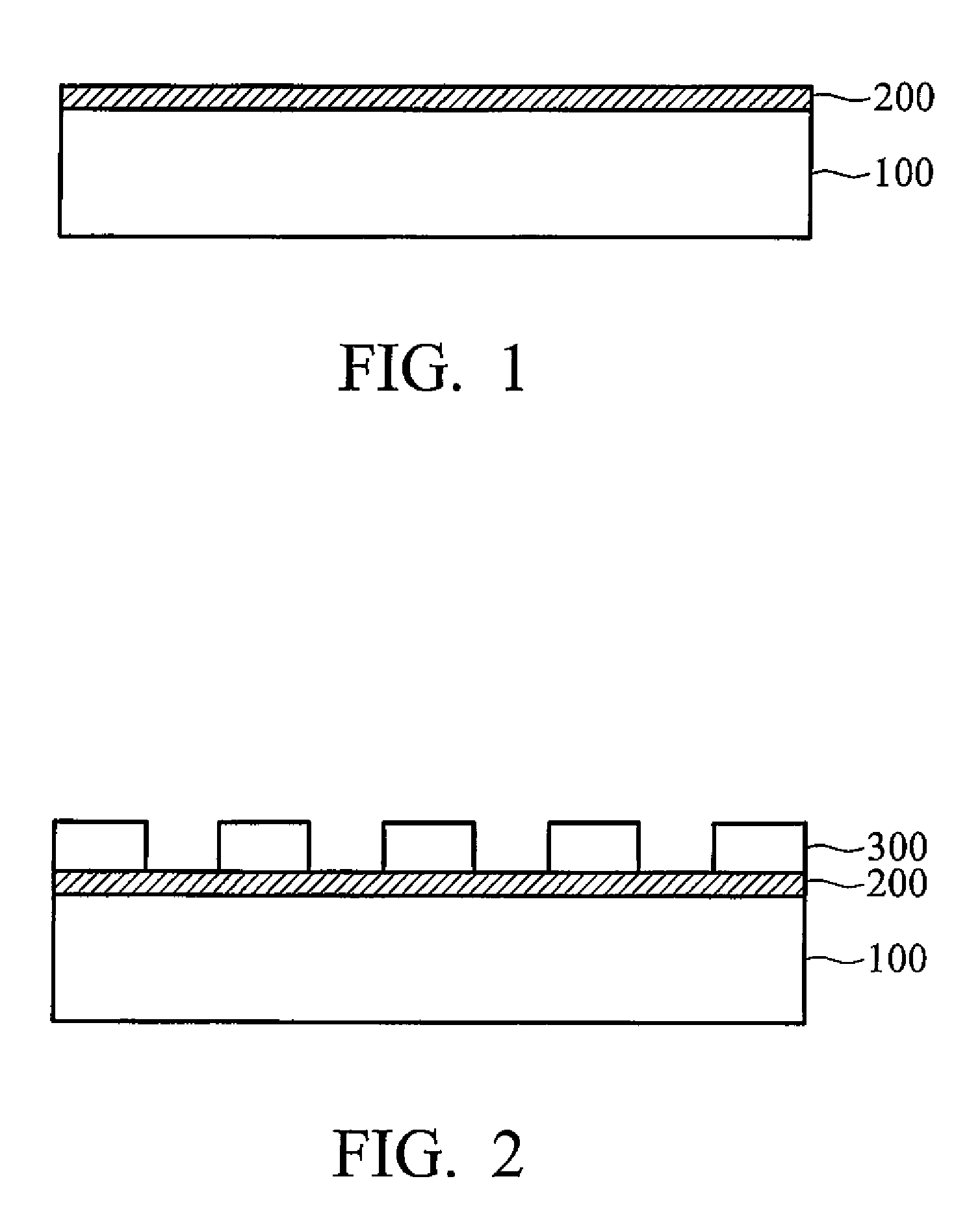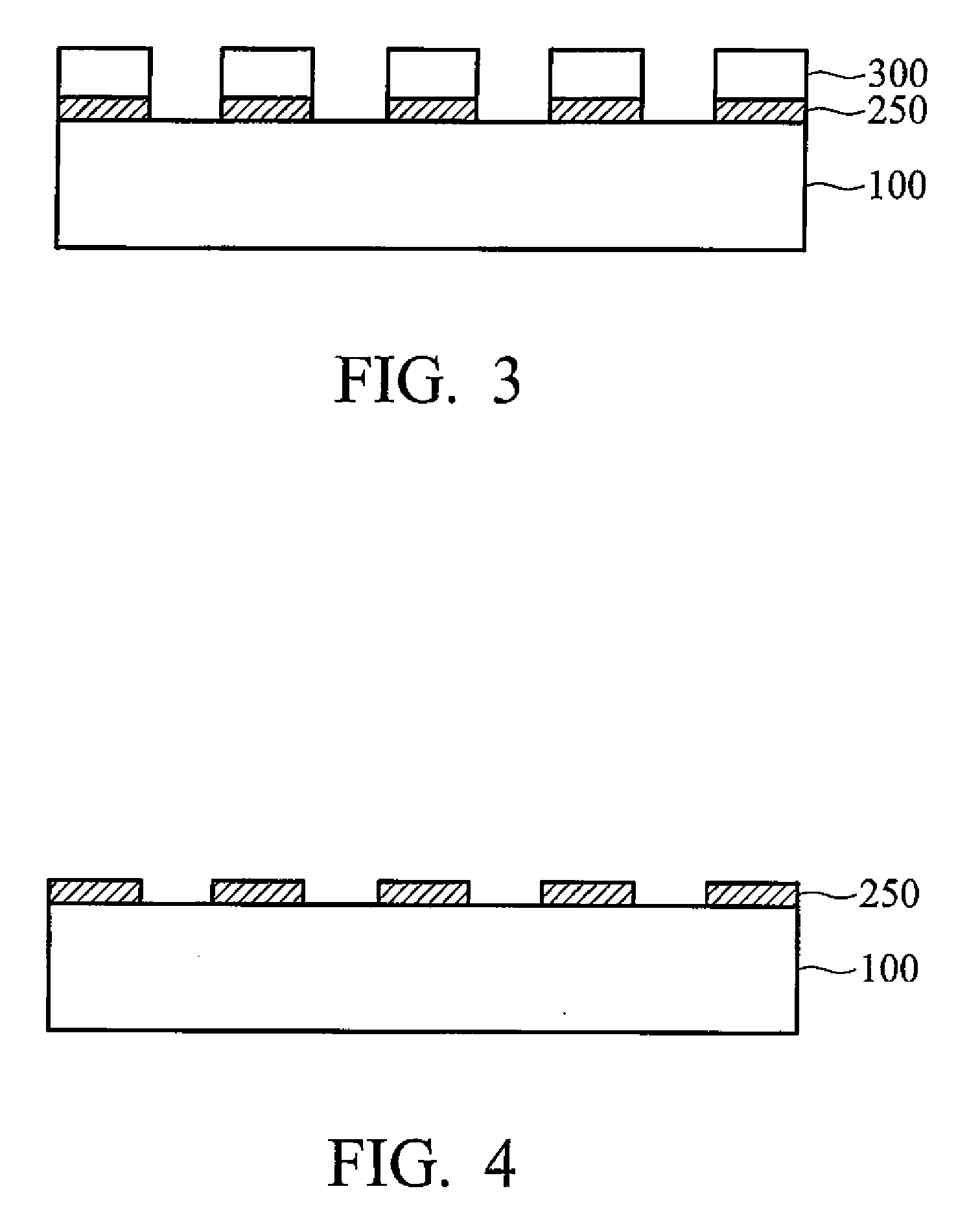Method for fabricating conductive pattern on flexible substrate and protective ink used therein
a technology of flexible substrates and conductive patterns, applied in the direction of lithographic masks, circuit masks, non-printed masks, etc., can solve the problems of inconvenient mass production of flexible electronics, high cost equipment, and time-consuming steps of photolithography processes
- Summary
- Abstract
- Description
- Claims
- Application Information
AI Technical Summary
Problems solved by technology
Method used
Image
Examples
example 1
[0028]An epoxy resin solution was prepared as follows: 15 parts by weight of a bisphenol A epoxy resin (“BE 188”; Chang Chun Petrochemical Co.), 11.6 parts by weight of an epoxy resin (“BE 325”; Chang Chun Petrochemical Co.), and 37.3 parts by weight of a hydroxyl-containing bisphenol A epoxy resin (“BE 500”; Chang Chun Petrochemical Co.) were dissolved in 126 parts by weight of propylene glycol monoethyl ether (PGME), and stirred under nitrogen at 125□ for 4 hours. The mixture was cooled to 80□, and then 9.7 parts by weight of 4,4-diamino diphenyl sulfone (from Echo Chemical Co.) was added and stirred for 120 minutes. After cooling to room temperature, an epoxy resin solution was obtained.
[0029]A protective ink was prepared as follows: 91.4 parts by weight of the above prepared epoxy resin solution, 2.05 parts by weight of an anti-tack agent (“LYSURF DF-300”; LYSURF CHEMICAL Co.), 1.05 parts by weight of a defoaming agent (“LYSURF LB-961A”; LYSURF CHEMICAL Co.), 1.5 parts by weight...
example 2
[0030]15 parts by weight of vinyl chloride-vinyl acetate-maleic acid terpolymer resin (VMCH) was dissolved in 81.3 parts by weight of ethylene glycol monobutyl ethyl acetate (EGMEA) at 90° C., followed by addition of 0.2 parts by weight of a thickening agent (“BYK 410”; BYK Co.), 1.5 parts by weight of a leveling agent (“BYK 344”; BYK Co.), 1 part by weight of a defoaming agent (“BYK A501”; BYK Co.) and 1 part by weight of blue ink (containing 20% of blue pigment, produced by Industrial Technology Research Institute, Taiwan), thus resulting in protective ink B with a solid content of about 16.4%. The composition of protective ink B is listed in Table 2.
TABLE 2Composition of Protective Ink BVMCH terpolymer resin15parts by weightEGMEA81.3parts by weightDefoaming agent (BYK A501)1part by weightLeveling agent (BYK 344)1.5parts by weightThickening agent (BYK 410)0.2parts by weightBlue ink (20% blue pigment)1parts by weight
example 3
[0031]1 part by weight of blue ink (containing 20% of blue pigment, produced by Industrial Technology Research Institute, Taiwan) was added to 20 parts by weight of a thermoplastic polyurethane elastomer (Estane 5715) and 78.4 part by weight of carbitol acetate(diethylene glycol monoethylether acetate), followed by addition of 0.6 parts by weight of a leveling agent (“BYK 344”; BYK Co.), thus resulting in protective ink C. The composition of protective ink C is listed in Table 3.
TABLE 3Composition of Protective Ink CEstane 571520parts by weightCarbitol Acetate78.4parts by weightLeveling agent (BYK344)0.6parts by weightBlue ink (20% blue pigment)1parts by weight
PUM
| Property | Measurement | Unit |
|---|---|---|
| width | aaaaa | aaaaa |
| width | aaaaa | aaaaa |
| thixotropic index | aaaaa | aaaaa |
Abstract
Description
Claims
Application Information
 Login to View More
Login to View More - R&D
- Intellectual Property
- Life Sciences
- Materials
- Tech Scout
- Unparalleled Data Quality
- Higher Quality Content
- 60% Fewer Hallucinations
Browse by: Latest US Patents, China's latest patents, Technical Efficacy Thesaurus, Application Domain, Technology Topic, Popular Technical Reports.
© 2025 PatSnap. All rights reserved.Legal|Privacy policy|Modern Slavery Act Transparency Statement|Sitemap|About US| Contact US: help@patsnap.com



